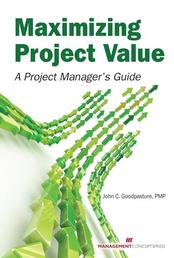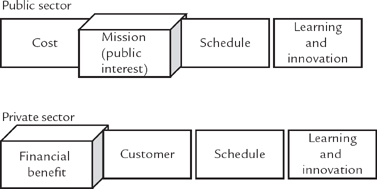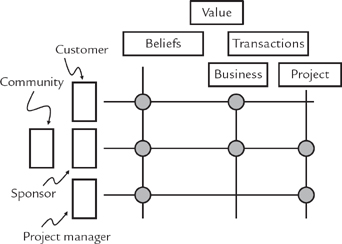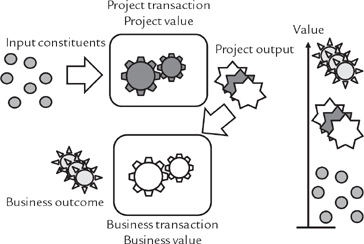Maximizing Project Value
A Project Manager's Guide
John Goodpasture (Author)
Publication date: 02/01/2013
Find out more about our Bulk Buyer Program
- 10-49: 20% discount
- 50-99: 35% discount
- 100-999: 38% discount
- 1000-1999: 40% discount
- 2000+ Contact Leslie Davis ( [email protected] )
John C. Goodpasture, PMP, is managing principal at Square Peg Consulting, LLC. He has dedicated his career to system engineering and program management, first as program manager at the National Security Agency for a system of "national technical means" and then as director of system engineering and program management for a division of Harris Corporation. He retired from Lanier Worldwide as vice president for Professional Services Process and Projects. Mr. Goodpasture has authored numerous papers, industry magazine articles, and books on project management, including Managing Projects for Value, also published by Management Concepts Press.
CHAPTER
1

UNDERSTANDING THE VALUE OF PROJECTS
Every individual endeavors to employ his capital so that its produce may be of greatest value. He generally neither intends to promote the public interest, nor knows how much he is promoting it. He intends only his own security, only his own gain.
—Adam Smith
The Wealth of Nations
Let us begin our discussion about the value of projects with this idea: Project value is the worth of a project’s throughput, or the difference in business value measured before and after a project, as earned during the course of the project schedule. Business value is the worth of a project’s throughput applied to business needs, as measured over some business duration. Maximizing project value is really about optimizing and managing the tension between the project manager’s mission to manage for project value and the project sponsor’s charge to enhance business value. Managing the tension between business and project value is tantamount to optimizing project success in the context of business success. Such optimization—actually, the avoidance of suboptimization—is a trade-off of value propositions between and among projects and the business, and is a form of risk management aimed at both project and business objectives, as illustrated in Figure 1-1.
Business value and project value are usually in balance, meaning that the best value outcome of the project is also a best value outcome for the business. But sometimes a specific project is suboptimized for the larger benefit of the business. Thus, in Figure 1-1 risk management and optimization are illustrated as activities that affect the balance of the project with the business. The aim of risk management and optimization is to effect the best overall outcome as valued by the business. Indeed, in portfolio management (to take one example), a specific project is sometimes suboptimized for the larger benefit of the business. Tools have been developed specifically for handling such optimizations. (Another example, to be discussed in Chapter 12, is game theory, which is used to evaluate “what-if?” optimization scenarios among competing strategies.)
FIGURE 1-1 Value Tension
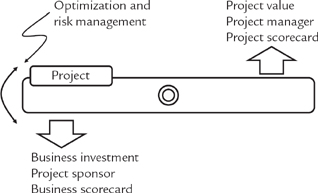
The project is optimized for the larger benefit of the business.
Projects are most successful when executives, sponsors, stakeholders, and project managers all share the idea that projects exist only to promote and benefit the organization at large.1
Project success, payoff, or value attainment is measured with several different metrics, some of which inform the project scorecard and others the business scorecard. Both scorecards reflect the biases and beliefs held by all the managers and organizations involved. For instance, in the public sector, mission—representing the public’s interests—usually dominates cost. In the private for-profit sector, financial benefit always dominates, or at least is first among equals. We see these ideas illustrated in Figure 1-2.
Scorecards reflect beliefs and biases.
DEFINING VALUE
On one level, values are what people believe in, a “truth” of sorts that needs no proof; on another level, value expresses a sense of worth, and it is transactional. This chapter will develop two conceptions of value:
1.Value as beliefs
2.Value as worth exchangeable in a transaction.
Value as worth has two transactional metrics:
1.Business value
2.Project value.
The community of project principals is influenced in its thinking and behavior by exposure to and experience with these value concepts. The entire community is guided by its value beliefs; however, acceptance and utilization of transactional values varies according to specific situations. A two-sided matrix diagram with intersecting points is a convenient way to illustrate who (on one side) is guided or influenced by what values (on the other side). One example of this who–what relationship is illustrated in Figure 1-3.
One possible set of relationships is shown in the matrix. At each intersection, if there is an interaction (influence) of one side with or on the other, the intersection is shown as a small grey circle. If there is no circle, there is no relationship at an intersection.
Beliefs and value transactions inform projects and business.
In this particular example, the absence of a circle at the intersection of the transactional business with the project manager indicates no direct relationship between the project manager and the transactional value of the business. (Presumably, the project manager goes through the sponsor to reach the business indirectly, but that idea is not shown here.)
Value as beliefs
Value as a personal belief is just there. People hold these beliefs without reservation. No second party is needed; no validation or affirmation is needed. Such beliefs are a moral and ethical code of sorts; collectively, they form culture. Belief values are conveyed in the culture of the community and in the environment of an enterprise, business, or operating entity. Persons living together in a common culture generally share many beliefs. For example, here’s one widely shared belief:
“… that they are endowed by their Creator with certain unalienable rights …”
The effects of leadership on cultural values are hard to understate. In this regard, portfolio managers, program managers, and project managers have a special role to play in developing and applying cultural values in project activities. Project managers are leaders as well as managers. As leaders they influence personal and interpersonal performance; they instill and promote culture. As managers they measure results and effect corrections. Indeed, their qualities of leadership become inextricably entwined with the values that they espouse.
Leadership is either directional—“Follow me; I have the answer”—or rallying: “Here’s the problem; let’s pull together to find the solution.” Each in its own way influences values and doctrines. Possible effects of both kinds of leadership appear in Table 1-1.2
In both the public and private sector, cultural beliefs become doctrine. Doctrine is built from the top down; it reflects the beliefs, attitudes, and strategic policy of the organizational leadership. Consider these examples of beliefs:
•Quality is free.
•There’s no substitute for ethical, honest, and transparent transactions.
•Community partnership is good business.
•Employees are inherently trustworthy.
TABLE 1-1 Leadership System
| Leadership Approach | Influence on Values and Doctrine |
| Directional |
|
| Rallying |
|
Though generally well-grounded and felt deeply, cultural values and doctrine are nevertheless subject to modification and evolution over time. Ronald A. Heifetz, a leading academic in the field of leadership, writes: “Values are shaped by rubbing against real problems, and people interpret their problems according to the values they hold.”3 To Heifetz’s statement we add: people shape their responses to events and circumstances according to the values they hold. In business, values prescribe ethical and legal performance but also should depend upon the three Rs:
•Respect for individuals, the environment, and community
•Exercise of responsibility for one’s actions
•Restraint from risky and provocative behavior that impacts project objectives.
Business culture or doctrine is often extended to a value system that incorporates beliefs that in turn inform business doctrine. Such a system of values as beliefs also includes principles that support doctrine. Principles are actionable statements; they endow behavior but also impose limitations. Thus, like any other system, a value system is a structure of interrelated elements supporting defined behavior and protocols.4 Table 1-2 details one example of a value system.
Value as worth
Value is the worth we place upon something for which we are willing to give up something else.5 In other words, worth or worthiness has a transactional aspect, and thus we speak of transactional value. The transaction has these elements:
•At least two parties
•A bilateral agreement about worth
•A joint willingness to enter the transaction
•A capability to meet the transactional demands.
Since the transaction requires willingness, the value of the transaction is somewhat subjective: what one might be willing to pay another may not. Willingness used this way is a form of utility judgment. In Chapter 5, we discuss utility in the context of cognitive biases that inform many kinds of transactions.
TABLE 1-2 Value System as Business Doctrine
| Belief | Principle |
| Quality is free. | We value doing the right job (value adding) in the right way (training and skill development) the first time (correct systemic errors). |
| There’s no substitute for ethical, honest, and transparent transactions. | As leaders of (entity), we (establish and promote a culture to) conduct business legally, with good order and protection for staff, according to reasonable and customary conventions. |
| Community partnership is good business. | As members of (community), (entity) is a willingly good steward of the environment and a committed partner in promoting the welfare of the community. |
| Employees are inherently trustworthy. | We (establish and promote a culture to) trust first, then verify, to avoid deliberate obfuscation, ambiguity, and duplicity. |
The exchange between parties may be zero-sum: someone loses and someone gains. However, in most project situations, the interesting transactions are non–zero sum. They are value trades, and each party to the trade is a winner, or at least not a loser.
In projects, the transaction is transformative: raw materials and resources—the constituent inputs of projects—are transformed by various processes into something usually quite different, the value of which far exceeds the simple sum of the input values. Thus, in the course of the transaction, there is value-add: there is a measurable difference in value between the sum of the inputs before the transaction and the sum of the outputs after the transaction. To attain value-add becomes a specific transactional objective. For this to be possible, value is not conserved. That is, there is no limit to the value-add of the project; the value of the project evaluated at its conclusion is certainly not constrained to the value of its cost input (resource cost). Indeed, the synergy among all the project deliverables may far exceed the cost value of the project resources. For this reason, the value of a project is better described by its value added than its resource cost.
CONCEPTS OF BUSINESS VALUE
As the terms are used in this book, business value and project value are forms of transactional value. However, no business, and no project, whether in the public or private sector, operates independently of beliefs that inform business culture. Thus, value as beliefs—being as they are an essential constituent of culture—influences all forms of transactional value. But for purposes of explanation, we discuss concepts of business value exclusive of a specific business culture.
Business value
When we say business value, we are thinking of the value of the business to its stakeholders as measured on the business scorecard. Every business has some sort of scorecard that keeps track of measurable attributes, whether monetized or not. Every business executive and project sponsor is attuned to maximizing the business scorecard—in effect maximizing business value. In this book, we posit that the best way project managers contribute to maximizing value is to deliver a best value outcome. Best value is the most valuable set of outcomes possible for the available investment, risk, and constraints. Best value is not necessarily best financial benefit; best value can be the best possible outcome of any scorecard metric.
Best value at the project level maximizes value at the business level.
Data on a scorecard is a point-in-time snapshot; looking at the difference between any two snapshots gives a sense of value difference. If there’s been an increase in value from one point to another, then the processes of the business have added to the business value—in other words, there’s been “value-add.” Indeed, we could fashion a value-add scorecard that tracks only these differences.
We can think of a project as a business process, albeit one that has a specific beginning and ending. In the doing, a project has the potential to add business value, because ideally project output is more valuable than its inputs—money, materials, and labor. In this sense, projects have a transformative effect for business value purposes: put something in, turn the crank—transformation occurs here—and output appears that is altogether different from any of the inputs.
To this point, the project output is inventory to the business balance sheet. In effect, one class of inventory and assets—money, materials, and labor—is replaced on the balance sheet by another—project outputs (deliverables). But the true value to the business is unrealized. The deliverables’ potential is realized only where they are applied to value-adding applications in the business.
Outcomes for the business are a consequence of project deliverables applied to the business scenario.
The most telling example is a new product development project. Many thousands (or millions) of dollars may be invested in research and development for the product, but the business potential may be many times more than the investment made in the project. In fact, in many situations, the project actually drains business value in spite of the balance sheet effects; not until the outputs find their way into business operations does value recover to break-even and beyond.
Thus there is a value scale of increasing value-add as one set of assets is used to create another more valuable set. Figure 1-4 illustrates the idea that each output, as represented by the different symbol sets, is more valuable than the prior output. Each successive output goes through some process, as represented by the boxes with gears, that adds value to its input (a prior output). Thus, on the sidebar, we see a vertical column of outputs in sequence order on a value scale, each one more valuable than its predecessor.
Constituents attain value from transactions.
Mission and vision impacts on value
Business value begins with mission. Whether stated or implied, every organization has some purpose and mission that drives achievement. Mission is the compelling motivation that inspires, motivates, and attracts stakeholders. As an example familiar to many, Google’s mission is to organize the world’s information.6 But mission needs a narrative to animate and guide the way; vision is the name given to this narrative. In Google’s case, the company’s narrative is best captured by its essay “Ten things we know to be true.”7
From vision and mission, opportunity is developed, though in reality it sometimes appears as an epiphany—inexplicable except in hindsight. Despite the myth in project management that “it takes a process,” in reality there might be no process at all; a perfectly valid opportunity might just be an idea for which there’s no rational predecessor. And this is OK! But to exploit opportunities, business needs a process. For this we look to Chapter 2, which picks up the discussion about how goals drive strategy, operating concepts, programs, and projects.
Value perspectives
Sponsors, project managers, and customers, users, and other affected stakeholders all have their own perspectives about the urgency, importance, and effectiveness of project results, and many have their ideas of what the cost and price should be. In one way or another, each group of stakeholders has its own scorecard:
•The project sponsor has a business investment scorecard reflecting the following priorities:
 Set expectations that will be effective for the business for the urgency, importance, and character of outputs.
Set expectations that will be effective for the business for the urgency, importance, and character of outputs.
 Make an investment in the project.
Make an investment in the project.
 Subsequently apply project outputs to obtain business outcomes that are more valuable than the investment.
Subsequently apply project outputs to obtain business outcomes that are more valuable than the investment.
•The project manager has a project scorecard reflecting other priorities:
 For the available investment, return the expected outputs in a best value sense.
For the available investment, return the expected outputs in a best value sense.
 Take guidance for decisions and trade-offs from the sponsor’s expectations.
Take guidance for decisions and trade-offs from the sponsor’s expectations.
 Look for validation from both stakeholders and customers/users; maintain fidelity with their needs and wants to the greatest extent possible.
Look for validation from both stakeholders and customers/users; maintain fidelity with their needs and wants to the greatest extent possible.
•The customer, user, or other stakeholders are a diverse community with no common scorecard among them. Each of these groups of stakeholders will have its own perspective on what is valuable and what is not; each will make a decision in the context of need, their willingness to transact, and their capability to employ the outputs usefully.
Table 1-3 describes value from the perspective of the three major constituencies: sponsor, project manager, and project beneficiaries—customers, users, and other stakeholders.
Another perspective is that shown in Table 1-4. Here we see a simple mapping by business sector according to objectives. Sector objectives express a mission, for example to provide for “satisfaction of public need.” The project manager, representing the project, also has a sector objective. For example, in the public sector, the project manager’s mission is to return best value outcomes to give the taxpayer the “most bang for the buck.”
| Sponsors | Project Managers | Project Beneficiaries |
| Value is achievement of business scorecard objectives | Value is delivery of outputs according to the business case and the project charter | Value is being better off, more effective, and more efficient than before |
| Project output is applied to the business to produce business outcomes | Outputs must be compatible with business purpose | Adoption of outputs produces business outcomes |
TABLE 1-4 Project Objectives by Business Sector
| Sector | Sector Objectives as Mission | Project Manager’s Objectives |
| Public sector |
|
Best value outcomes (most bang for the buck) |
| Nonprofit or voluntary organization |
|
Simplest outcomes that serve constituent interests |
| For-profit business |
|
Maximized scorecard impact |
Value scorecards
Projects are not the everyday business of most organizations.8 Projects are unique endeavors, and for many, they are a little bit mysterious, guided by methodologies and doctrine not familiar to those outside the domain of project management. Likewise, business practices, focused as they are on day-to-day operating activity, are not ordinarily employed or completely understood by project managers. Thus we can imagine that the scorecards kept by organizations in general and by project managers are going to be dissimilar. However, they do interconnect in some ways, particularly on financials, as shown in Figure 1-5.
A business scorecard may have many metrics, and these will differ in content and emphasis according to sector—public, private, or nonprofit. As Michael Treacy and Fred Wiersema described in their seminal description of value disciplines,9 the scorecard may emphasize a close customer relationship, or an excellent product line, or perhaps the most efficient operational capability. But it’s not likely to emphasize all three. One is more likely to influence mission and values the most.
FIGURE 1-5 Scorecard Intersection
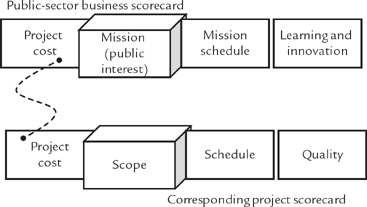
Business and project scorecards join at cost.
Scorecard measures typically include a financial metric but may also include:
•Market and sales metrics
•Operational efficiency metrics
•Customer and customer support metrics
•Product and innovation metrics, including independent research and development
•Staff development metrics
•Manufacturing and distribution metrics.
The business scorecard picks up the transformative effect of projects: business assets are invested and transformed into different asset classes. In doing so, it can be presumed that the project team achieves the best that can be achieved. We call this best value.
Best value is a dynamic trade between feature, function, and performance on the one hand with available resources on the other. In the public domain, where political pressures and statutory mandates have almost day-to-day impacts on projects, the antidote is providing best value. Who can reasonably argue against getting the most value for the taxpayer’s funds?
Nonprofits, funded as they are by private donors, must always weigh donor satisfaction with constituent service. An unsatisfied donor may not return, thereby starving future project activity. Beneficiaries of the nonprofit often have a political voice. That voice, in turn, has an effect on donor satisfaction, creating somewhat of a virtuous circle.
For-profit businesses are first and foremost in business to serve shareholder interests. In the modern era, shareholder interests are best served by extending past Milton Friedman, the Nobel economist, who famously said: “The business of business is business.” Consequently, the business scorecard is much more nuanced than a simple profit and loss statement. Since such a scorecard typically includes not only financial considerations, but also operational and customer considerations, a wide range of interests are represented on the modern scorecard.
The Boeing 787 Dreamliner is a new state-of-the art carbon fiber aircraft. As of 2012, Boeing is making its first deliveries of the 787 to customers—two years late and substantially over the development and test budget. However, production is sold out for several years; few advance orders have been cancelled. The aircraft has the potential to be as successful as the 747, which has been in production for 40 years. Why? Because the 787 addresses a wide range of needs and wants that inform the business scorecard of some of the most demanding customers (and of Boeing itself).
Failure is the flip side: no matter what project metrics inform the business scorecard, if the business is not in a better place after the project is complete, the project is not successful.10 For example, the “New Coke” of the 1980s was undoubtedly a successful development project—after all, New Coke did go into production and distribution. But it was a market failure, so in a larger sense, within the business context, New Coke was not a successful project.
Value with utility
Many things hold transactional value. Consequently, parties often find themselves bartering or exchanging one thing for another: assets the business owns—like money, resources, and materials—are exchanged over time for assets the business would rather have or wants more. Objective value is the value that a disinterested neutral party places on the assets. However, what one sponsor may be willing to pay or invest for deliverables may be quite different from what another is willing to do. And in transactions generally, what one party finds valuable another may not. These are examples of utility; utility is the perceived value of the transaction rather than the objective value.
Utility expresses the functional relationship between perceived value and objective value; utility influences the “price” that a party capable of paying is willing to pay. Willingness to pay is often a matter of how satisfied—or how much more satisfied—we will be once we have attained what we want. As such, utility is not linear. Rather, there is often a decreasing margin of value with each added unit.
Increasing wealth from $5 to $10 has greater utility than increasing wealth from $1,000 to $1,005.
Choosing, and decision-making generally, engages these concepts of value. One project is chosen over another for its greater utility to the business. Utility draws both belief value and transactional value into the choice. In other words, beliefs influence perception, and perception influences the impact of objective value.
CONCEPTS OF PROJECT VALUE
Projects are not valuable in and of themselves; they acquire value only as an instrument of strategy to exploit opportunity. This idea drives our concept of project value.
Value for projects is derived from the potential value of business goals.
The concept of project value is a different proposition than business value for the same project. Richard Stengel wrote in Time magazine, “Where you stand is where you sit.”11 If your seat is project management, for the most part you stand for project metrics: scope, cost, schedule, and quality. The integrated results of scope, cost, schedule, and quality are project outputs—deliverables—that then lead to business outcomes.
Project value is about deliverables—output; business value is about the consequences of output applied to the business.
Ordinarily, projects are undertaken only to satisfy a business need that cannot be otherwise met. Projects are organized sets of nonrecurring tasks employed to do one thing one time. A project, once chartered, represents a judgment about the opportunity cost of satisfying needs at the expense of resources. After all, projects consume resources—resources that might be otherwise employed to the benefit of the organization. But the project manager’s mission is to enable the development of business value from opportunity that would be otherwise lost if not for project success.
Mission as a primary project value
No one should discount the potential of mission to arouse passion and drive practitioners to achieve extraordinary results. We usually think first of mission as a business goal and a justification for myriad business activities, but mission as a motivator transfers very well to the project context.
Mission is often promoted to the dominant project value. Like the paradigm known as the Theory of Constraints,12 the project management paradigm in the context of mission dominance means that everything else should be subordinated to mission. Thus, cost, schedule, quality, and scope are tucked in under mission.
There are many examples of mission dominance, especially since the big project era began in World War II. The Manhattan Project to build the atom bomb is perhaps the granddaddy of mission-dominant projects, costing some $28 billion in 2011 value. On another scale, the project to create an air scrubber for the Apollo 13 rescue was an example of mission dominance. Who does not remember “Failure is not an option”?13 Indeed, the case can be made that the whole space race to the moon was a mission-dominated portfolio of many programs and projects.
Earnable value
Earnable value is a straightforward management idea that is summed up by a simple idea: get your money’s worth. It works this way: first, the investment is planned, then the investment is earned.
•The investment plan is the budget for the project and is called planned value (PV). If there are no approved changes, the planned value is the baseline budget.
•Second, when an output is delivered, the output’s planned value is earned. Planned value earned is called earned value (EV).
Earnable value is a value accounting metric, not a cost accounting metric. The value earned reveals nothing about cost; in fact, the cost could be less than, equal to, or greater than the monetized value of the earning. If the actual cost does not exceed the earned value, the project is usually judged a financial success.
The value earnable is planned as the project’s budget.
A recent innovation is the concept of earnable schedule. Like its cost analogue, schedule for each output is planned. The schedule is earned when the output is delivered. The project is considered a schedule success if deliverables are early or on time.
Quality as a project value
The automotive industry is the poster child for the effects of the cost of quality. American automakers lost their industry dominance because of inattention to quality. Quality is not just a matter of whether the doors and windows fit. Quality includes many values, among them esteem value, which makes customers willing to pay; low cost of ownership; and high availability, which promote affordability and capability to pay.
The contemporary theory of quality attainment in projects is that quality is to be designed in, not policed in at the end. Quality by design depends on two factors:
•First, design itself has to have appealing qualities. Examples: Apple’s iPod, iPhone, and iPad.
•Second, and an imperative for project management: quality is dependent on minimizing systemic errors so that repeatably good results are achieved.
The need for repeatability has brought maturity models, process science, and defined methodologies into the project mainstream.
Repeatable performance, within limits acceptable to project beneficiaries, is highly valued by project managers and sponsors when quality is a dominating value.
Emergent value and progressive elaboration
Eberhardt Rechtin defines emergent value as value created solely by the relationships among elements in a system.14 By this, Rechtin means that the parts alone don’t really provide the value; the value is in the way the parts interact with each other in a system. In this context, a system is anything with a defined structure wherein there are behaviors and relationships among the structural members.
Similar to emergence is progressive elaboration. The idea here is that more detailed information is developed or is revealed as users or developers become more experienced with objects or requirements. Progressive elaboration may require some time to effect if experience is acquired serially, but it’s also possible to assemble the improved information from parallel activities of independent parties acting in the same time frame.
In the presence of emergent value and progressive elaboration, scope is elastic though contained by the limitations and constraints of time and cost and the standards of quality. Thus, project managers and project sponsors strike a grand bargain: in trade for latitude to manage emergent value and progressive elaboration of scope, the project manager will respect the strict limitations of sponsors’ budget at completion and critical milestones.
What is important, urgent, and needed may change with time as the community begins to understand the deliverables. Emergent value lends itself to a best value paradigm: obtain the most value for the available investment in the time allotted, taking reasonable risks to do so.
Throughput value
Throughput is a metric from the Theory of Constraints. As noted earlier, it is the difference in business value measured before and after a project. See Figure 1-6 for an illustration.
Throughput accounting really focuses on the variable elements in the process. The fixed costs of maintaining a project office and project teams are not an input, since fixed costs are always present, whether for this project or some other. Consequently, the management team focuses on its discretionary choices. Scope and schedule are consequences of the capacity of the constraint: a tightly held constraint will not allow much scope in a fixed time box.
FIGURE 1-6 Throughput
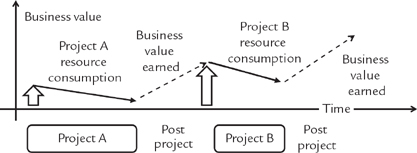
Throughput builds business value over time.
Managers focus on their discretionary choices, given the constraint that the project has a fixed capacity to produce outputs.
SUMMARY OF KEY POINTS
This chapter addresses three key questions:
1.How is value defined?
2.What do we mean when we say business value?
3.What do we mean when we say project value?
In response to the first question, we posit that there are two definitions. One definition is that values are beliefs, accepted without proof. But another definition is that values are transactional: something of worth is traded or transacted for something else of value. Utility—that is, perception—joins the two concepts of value: perceived worth incorporates beliefs about what it is about something that makes it valuable, and the transactional exchange of one worthy asset for another.
Business value is about one view of transactional value, whereas project value is the other view. Sponsors and project managers each have their own scorecard of value, the former for business value and the latter for project value. Business value is the net improvement in the business for having successfully completed a project and applied its outcomes to the business. Net improvement might be measured differently by public-sector managers, private-sector managers, or not-for-profit managers. The measurement might be in terms of mission success, monetary success, learning and innovation, or some other metric.
Projects are valuable because they are the means to extract value from opportunity through managed application of resources. There are many forms of project value, including earnable value, quality as a value, and mission satisfaction. Any of these that apply to the project are on the project scorecard, and they may have related metrics on the business scorecard. Insofar as net business improvement is the focus of both the sponsor and other stakeholders, the project manager may focus only on throughput. Throughput is a measure of the value-add of discretionary investment in projects.
Of course, sometimes the value proposition of a project changes or evolves, or the utility of the value proposition changes. One related idea is emergence. Emergent value is a consequence of many interactions that were not seen until the deliverable was in its final form.
In the next chapter, we extend the discussion of value. How does a business opportunity become connected to a specific project? We address this question by looking at value flow-down, from business opportunity, through the business, to a project.
NOTES
1.The terms business, enterprise, and organization are used interchangeably.
2.R. Heifetz (1994) defines transactional and adaptive leadership as the two leadership activities that affect most situations—transactional being influencing interactions between leader and follower, and adaptive being mobilization to solve problems. The book emphasizes the latter as the most productive for society.
3.R. Heifetz, Leadership Without Easy Answers (Boston: Harvard University Press, 1994), 22.
4. D. Meadows, Thinking in Systems: A Primer (White River, VT: Chelsea Green Publishing, 2008), 2.
5.Some caution is in order: when we say “at one level this, and at another level that,” what really may be the case is that we’re linking domains, using the same or similar word in each domain to link them where otherwise there might not be a link. The reader may reasonably question whether a value system of beliefs is in the same hierarchy with the monetized value of an object. In this book, the linkage is made because many objects of project value do not have monetized value, and are valuable because they are an instantiation of beliefs. Mission satisfaction is one such example.
6.Google’s mission statement can be found at http://www.google.com/about/company.
7.The essay can be found at http://www.google.com/about/company/philosophy.
8.Business, used in this context, refers to organizations of all types, including governmental, not-for-profit, volunteer, and the traditional profit-earning enterprise. For many businesses, like construction, consulting, and product development, projects are the day-to-day business and the lifeblood of their operations. For all the rest, projects are employed to change the business but are not core to the operations of the business.
9.M. Treacy and F. Wiersema, “Customer Intimacy and Other Value Disciplines,” Harvard Business Review (Jan. 1993).
10.The idea of potential business value is about responsibility: the time frame of value accumulation and evaluation is different for sponsors, project managers, and beneficiaries. When the project ends, the project manager’s responsibilities end; the value of outcomes at project end may be unrealized until the product is sold or processes are deployed and employed, or other mission aspects are made operational.
11.R. Stengel, “The Constitution: Does It Still Matter?” Time (June 24, 2011).
12.Eliyahu Goldratt is credited with naming the theory of constraints. The basic idea is to identify the one immovable constraint that limits output (which Goldratt called throughput) and apply all necessary effort to relieve the constraint.
13.G. Kranz, Failure Is Not an Option: Mission Control from Mercury to Apollo 13 and Beyond (New York: Simon and Schuster, 2000), 12.
14.E. Rechtin, “Systems Architecting of Organizations: Why Eagles Can’t Swim” (CRC Press, LLC: 2000), 4.


